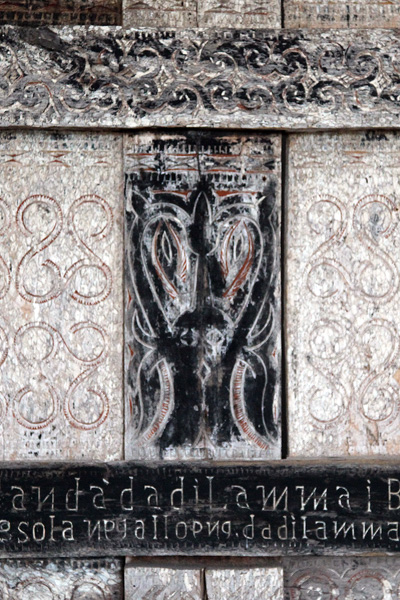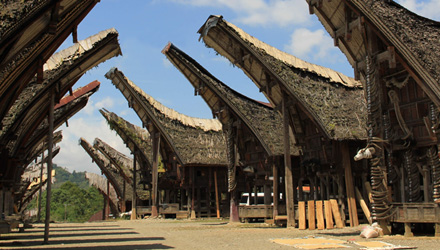Toraja Tongkonan or Ancestral House Panel
 |
|
"Toraja people are renowned for burial sites carved into rocky cliffs, colorful wood carvings, and peaked roof traditional houses known as Tongkonan. Tongkonan are the ancestral houses of the Toraja"
The Toraja are an ethnic group indigenous to a mountainous region of South Sulawesi, Indonesia called Tana Toraja, which translates as “Land of the Toraja.” Before the 20th century, most Torajans lived in autonomous villages and the vast majority practiced animism, the belief in the existence of individual spirits that inhabit natural objects and phenomena. In effect, they were untouched by the outside world.
 |
|
In the early 1900s, Dutch missionaries worked to convert the people to Christianity. By the time the Tana Toraja regency was established in 1946, one year after Indonesian Independence, very few Torajans still practiced their ancient beliefs, which the Indonesian government called Aluk To Dolo, meaning “way of the ancestors.” Today, most Torajans are Christian and some are Muslim. The few who are still animist place a heavy emphasis on ancestor worship, and this relates to this carved wooden panel.
The Toraja language is only spoken; no writing system exists. To express social and religious concepts, especially among those adhering to traditional ways, Torajans carve wood, calling it Pa’ssura, which means “the writing.” Torajans are renowned for burial sites carved into rocky cliffs, colorful wood carvings, and peaked roof traditional houses known as Tongkonan. Tongkonan are the ancestral houses of the Toraja. This house panel comes from a Tongkonan.
Tongkonan stand high on wooden piles, topped with a layered split bamboo roof shaped in a sweeping curved arc. They are typically incised with red, black and yellow detailed wood relief carvings on the exterior walls. Each carving receives a special name, and there are numerous motifs ranging from figurative to abstract. Regularity and order are the most common features in Torajan wood carving with geometry playing a central role. Torajan carving has actually been studied by the obscure science of ethno mathematics.
 |
 |
The word “tongkonan” comes from the Torajan word tongkan, meaning “to sit.” To the Toraja, the Tongkonan is more than just a structure. It is the center of their social and spiritual life – the focus of ritual life - and the symbol of family identity and tradition, representing all the descendants of a founding ancestor. It forms the most important nexus within the web of kinship. Torajans may have difficulty defining their exact relationship to distant kind, but can always name the houses of parents, grandparents and sometimes distant ancestors, for they consider themselves to be related through these houses.
There are many rituals associated with the Tongkonan, and because the structure represents links to their ancestors, most involve the participation of entire families. According to Torajan myth, the first Tongkonan was built in heaven on four poles with a roof made from Indian cloth. When the first Torajan descended to earth, he imitated the house and held a large ceremony.
Descent amongst the Toraja is traced bilaterally; that is, through both the male and female line. People therefore belong to more than one house. Membership of these houses only requires the kinsman's active participation at times of ceremony, the division of an inheritance or when a house is rebuilt. Unfortunately, today very few houses are being rebuilt as the Toraja themselves are subject to the increasing pressures of modernization and the abandonment of their old belief systems. Today, one might consider Tongkonan to be architecturally endangered.

|
|
| |
|
Download this Article: Toraja Tongkonan Ancestral House Panel.pdf